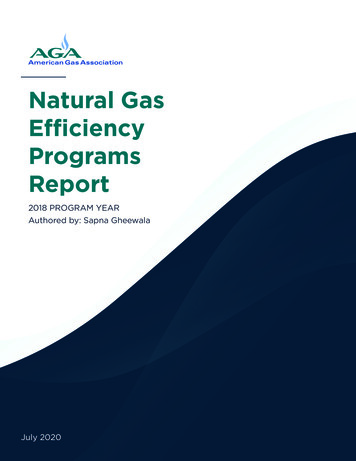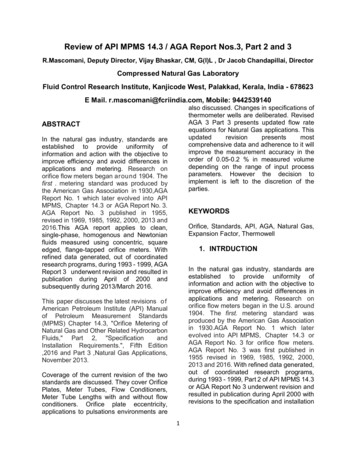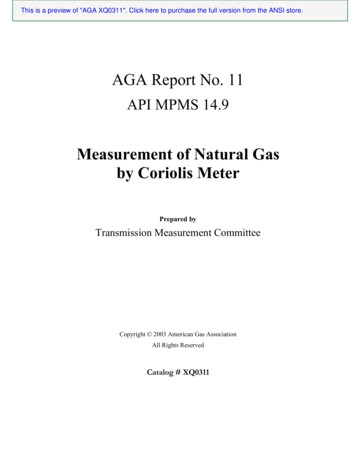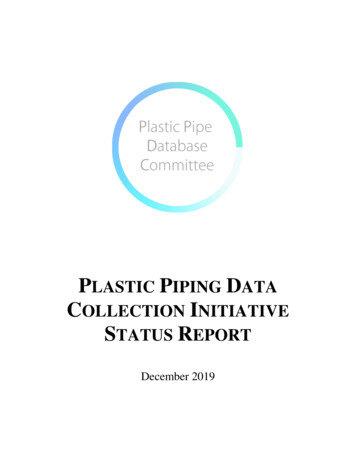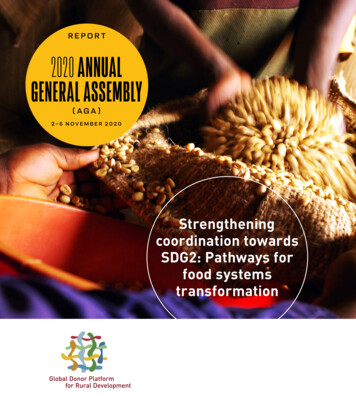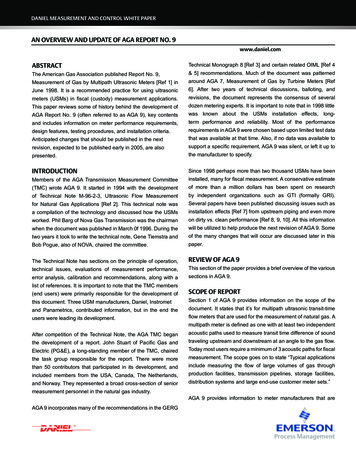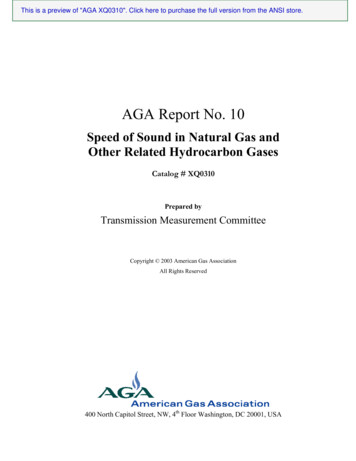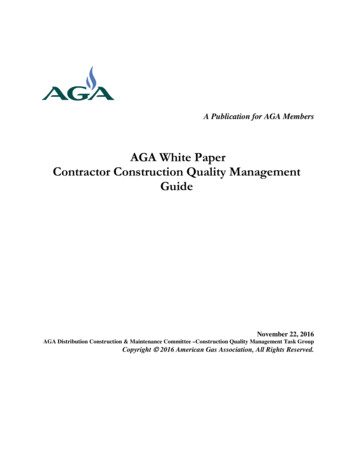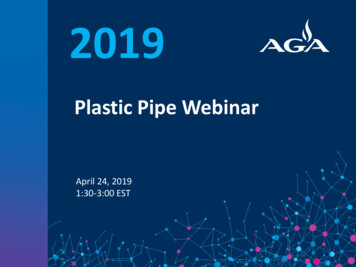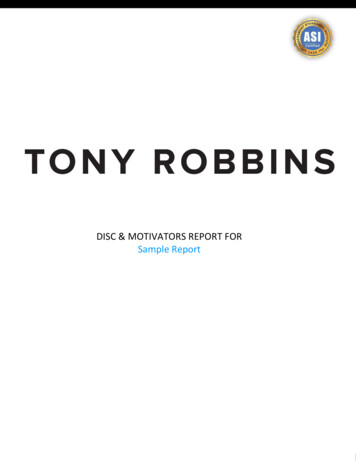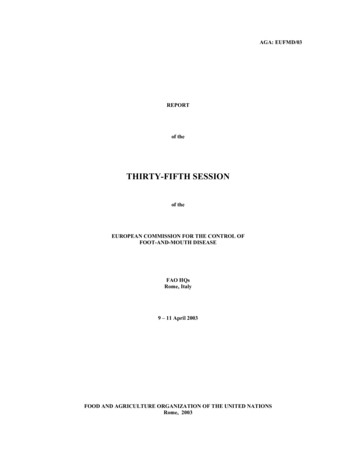
Transcription
AGA: EUFMD/03REPORTof theTHIRTY-FIFTH SESSIONof theEUROPEAN COMMISSION FOR THE CONTROL OFFOOT-AND-MOUTH DISEASEFAO HQsRome, Italy9 – 11 April 2003FOOD AND AGRICULTURE ORGANIZATION OF THE UNITED NATIONSRome, 2003
TABLE OF CONTENTSPageINTRODUCTION1Opening Ceremony: Address by Ms Louise O. FrescoAddress by Dr L. CeledaAddress by Dr Y. Cheneau135REPORT OF THE GENERAL SESSION5Item 1. Adoption of the Agenda5Item 2. FMD situation in 2002 and the first quarter of in 2003 Europe andin other regions; events and perspective- Keith Sumption and Dónal Sammin5Item 3.7Global FMD SurveillancePaper 3.1 Report of the FAO World Reference Laboratory – global FMDsituation during 2001/2002- David Paton7Paper 3.2 Risk assessment for the import of meat and meat products10contaminated with FMD virus into Great Britain and the subsequentexposure of GB livestock- Emma HartnettPaper 3.3 Global early warning and response system for major animal12diseases – a joint initiative to better combat diseases at source- Vincent Martin and Juan LubrothItem 4.Paper 4.1 Report on the Commission’s activities in 2001 and 200213- Keith SumptionItem 5.Report on FMD situation in TurkeyPaper 5.1 Report on the situation of FMD in Turkey15- Sinan Aktas15Paper 5.2 Overview of FMD control programme in Iraq with particular17reference to the Northern Governorates- Ahmed El IdrissiItem 6.FMD control in Commonwealth of Independent States (CIS)CountriesPaper 6.1Progress report on the EUFMD supported actions in FMDcontrol in the Rep. of Azerbaijan - Leos Celeda1919ii
PageItem 7.EUFMD activities related to FMD surveillance in neighbouringcountries21Paper 7.1FMD surveillance support for Central Asia - Keith Sumption21Paper 7.2Clarifying disease spread in the Eurasian Ruminant street- Jan Slingenbergh22Item 8.FMD diagnostic capacity in Europe24Paper 8.1 Contingency planning for FMD: Laboratory aspects- Tony Garland24Paper 8.2 Assessment of FMD testing requirements and diagnostic laboratory 25capacities of EUFMD Member Countries- Dónal SamminItem 9. FMD vaccine situation in the European Region27Paper 9.1 Report of the meeting at EDQM – the Eur. Pharm.and licensingof FMDV vaccines- Kris De Clercq27Paper 9.2 The availability of FMD vaccine for emergency use in EUFMD28Member Countries- Dónal SamminPaper 9.3 Note on the animal health surveillance – Impressions from an OIETechnical Consultation In Ft. Collins, Colorado, 17-21 March 2003- Preben WillebergItem 10. Issues relating to the new EU Directive- Keith SumptionItem 11.Paper 11.1 Report of the activities of the Research Group for theperiod 2001, 2002 and the first quarter of 2003- Kris De Clercq3030(36)31Item 12. Financial matters: Accounts 2001 and 2002 and proposed budgetfor 2004 and 2005- Keith Sumption33Item 13. Election of Chairperson, Vice-Chairpersons, members of theExecutive Committee and members of the Research Group34Item 14. Any other business36Item 15. Adoption of the draft report37Closure of the Session37iii
APPENDICESPageAppendix 1. FMD situation in 2002 and the first quarter of 2003 in Europe andin other regions; events and perspective - Keith Sumption38Appendix 2. Report of the FAO World Reference Laboratory – global FMDsituation during 2001/2002 - David Paton49Appendix 3. Risk assessment for the import of meat and meat productscontaminated with FMD virus into Great Britain and the subsequent exposure ofGB livestock - Emma Hartnett57Appendix 4. Global early warning and response system for major animaldiseases – a joint initiative to better combat diseases at source - Vincent Martin64Appendix 5. Report on the Commission’s activities in 2001 and 2002- Keith Sumption66Appendix 6. Report on the situation of FMD in Turkey - Sinan Aktas80Appendix 7. Overview of FMD control programme in Iraq with particularreference to the Northern Governorates - Ahmed El Idrissi88Appendix 8. Progress report on the EUFMD supported actions in FMD control in 96the Republic of Azerbaijan - Leos CeledaAppendix 9. FMD surveillance support for Central Asia - Keith Sumption107Appendix 10. Clarifying disease spread in the Eurasian Ruminant street- Jan Slingenbergh111Appendix 11. Contingency planning for FMD: Laboratory aspects– Tony Garland116Appendix 12. Assessment of FMD testing requirements and diagnostic laboratorycapacities of EUFMD Member countries - Dónal Sammin124Appendix 13. The availability of FMD vaccine for emergency use in EUFMDmember countries - Dónal Sammin136Appendix 14. Note on the animal health surveillance – Impressions from an OIETechnical Consultation In Ft. Collins, Colorado, 17-21 March 2003- Preben Willeberg148Appendix 15. Report of the activities of the Research Group for the period 2001,2002 and the first quarter of 2003 - Kris De Clercq152iv
PageAppendix 16. Financial matters: accounts 2001 and 2002 and proposed budget for 1582004 and 2005 - Keith SumptionAppendix 17. Spreadsheet detailing recommendations of General Sessiontogether with timeframe – Keith Sumption172Appendix 18. List of participants185v
INTRODUCTIONDr L. Celeda, Chairman of the EUFMD Executive Committee, opened the 35th GeneralSession and introduced Ms Louise O. Fresco, Assistant Director-General, AgricultureDepartment, FAO.OPENING CEREMONYAddress by Louise O. Fresco, Assistant Director-General, AGExcellencies, Ladies and Gentlemen,It is with great pleasure for me to welcome you on behalf of the Director-General of FAO, MrJacques Diouf, to this Thirty-fifth Session of the European Commission for the Control ofFoot-and-Mouth Disease.I should like to greet the Permanent Representatives to FAO, the Delegates and Experts of theMember Countries of the Commission, the Observers of the other countries and theInternational Organizations and to thank you for having accepted FAO’s invitation to takepart in this Thirty-fifth Session.Rome is a city of history and I wish to recall that it celebrated its jubilee year in 2000. TheEUFMD Commission is also approaching 50 years since its first Session was held in Rome inJuly 1954. The jubilee year of the Commission therefore falls in 2004, the period underconsideration for this Session. Approaching a 50 year anniversary stimulates reflection aswell as celebration.In Europe devastating outbreaks of FMD have been recorded which date back over severalcenturies. In looking back, it is remarkable how much has been achieved given the longhistory of FMD. Lasting control in Europe was achieved first by a few countries, and later bymany more, but it has not yet been achieved by all member countries.The history of FMD control in Europe was marked by very significant and rapid progress inthe first 10 to 25 years of the EUFMD, followed by the steadily improving situation enablingthe policy change to non-vaccination in 1992, and periods in the 1990’s where FMD wasconfined among EUFMD members only to Turkey. It must be recalled that following 1992,the existence of the EUFMD Commission came under question. Most fortunately theCommission continued to serve the member states and during the periods in the last 10 yearswhen the situation in the European Union members appeared to be very favourable, theEUFMD has provided timely warnings of the deteriorating situation in other parts of theworld, including, most notably, warnings of the threat from the deteriorating situation beforethe 2001 epidemic occurred in Europe.In considering the origin of the EUFMD Commission it is noticeable that it was stimulated byinternational needs and crises in Europe and encouraged by the enabling environment ofagreements between the governing bodies of FAO and OIE. The Commission was initiatedwith 6 member countries and has grown to its present membership of 33 countries through thecollective commitment of the member states.1
This Commission is not only interested in Europe – it has always had a global vision. In theyears between the first meeting in 1949 and the first Session of the Commission in 1954 theframework was established. Work then began to develop control methods and an overallstrategy for FMD control in Europe. The Commission has collaboration with the internationalorganizations, including FAO, OIE and the EU and through the medium of the severaltripartite groups also worked to support non member countries. The EUFMD has from thestart stimulated global progress in FMD control, an issue of as great importance today as itwas in 1954.Linking of efforts within and between regions has always been a principle feature of FAOactions and FAO recognises the importance of Regional Commissions to achieve concertedactions and progress in disease control.The Commission now includes 33 Member States, which means almost all of the countries ofEurope. Yet there remain 10 other potential members of the Commission, who are FAOmembers in the European Region, so the family may not yet be considered complete.I am told that virtually all the Member Countries are represented today.Amongst the many observers, I should also like to greet the Representatives of theInternational Organizations and in particular the representatives from the Office Internationaldes Epizooties and the Delegation of the European Commission.The OIE, and the predecessor of the EC have been involved with the EUFMD from the outsetand the achievements reflect this productive partnership.The joint activities of the European Commission for the Control of Foot-and-Mouth Disease,FAO, and your Organizations have been further strengthened in recent years: through the jointorganization of training workshops, joint sessions of the Research Group of the Commissionand experts on the disease in the countries of the European Union to, recently, theestablishment of a OIE/EUFMD/EC Tripartite Group to help control foot-and-mouth diseasein the countries of the Community of Independent States. We welcome this increased cooperation among our organizations as it allows greater effectiveness and better service to theMember Countries in the control of FMD.FAO is also very grateful to the European Union for the assistance that it continues to provideto the EUFMD Commission through the jointly managed Trust Fund, particularly for actionsin the protection of south-eastern Europe.This Session is timely for the issues raised by the current events in the Middle East. Foot-andmouth disease caused heavy loss of livestock in Iraq in 1999. FAO has been actively involvedin supporting animal disease control in Iraq, and in preparing for the consequences of thecurrent conflict for FMD control.Turkey and Iran play a key role in the Middle East as they are often the transit countries forviruses that can then threaten Europe, as in the case of the new variants of foot-and-mouthdisease type A and of type Asia 1, which were in fact introduced into Greece in the Summerof 2000.2
Although progress has been made in Turkey, the foot-and-mouth situation continues to be ofconcern in that country and the regions to the East. FAO has assisted through a regionaltechnical co-operation programme for the control of the disease, jointly undertaken withTurkey and Iran.Foot-and-mouth remains a major world disease and Europe's long-term protection can only beenvisaged if control measures are taken in all countries where the disease remains endemic.FMD has not yet been eradicated from Europe, however, this is a realistic goal and could bethe greatest challenge for the next 10 to 50 years. Many questions remain to be answered,many challenges still to be faced.With enlargement of the European Union in mind, it is appropriate for the EUFMDCommission to consider the enlargement of its vision. FAO is always ready to work towardsimproving the control of diseases throughout the world and will continue to provide itssupport to the Commission.Before closing, I wish to inform you of a change in the Secretariat of the Commission. DrYves Leforban left the Commission to return to duties in France. I wish to take thisopportunity to officially welcome the new Secretary of the Commission, Dr Keith Sumption.I thank you, and I wish you all a fruitful outcome of this Thirty-fifth Session of yourCommission.Address by Leos Celeda, Chairman of the European CommissionExcellencies, Ladies and Gentlemen,It is a great pleasure for me to welcome you here in Rome on the occasion of the Thirty-FifthSession of the European Commission for the Control of Foot-and-Mouth Disease.I should start by thanking FAO for having organised the meeting and Ms. Louise Fresco,Assistant Director General, Agriculture Department for the very kind opening speech.I am also very pleased to welcome the Delegates and experts of the Member Countries of thisCommission, representatives of the International Organizations, and observers who kindlyaccepted our invitation to this Session. I have received apologies from Luxembourg andIsrael who are unable to attend this meeting.Two years ago when we met here the working atmosphere was heavily influenced by thedramatic developments in the FMD epidemic in the UK and the majority of participants wereafraid of further virus spread on the continent of Europe. Many colleagues and organizationswere faced with the likelihood of combating the real disease in the days after the Session and Isincerely hope that the support and the solidarity expressed at many points in the 34th GeneralSession, and shared thereafter by the common commitment of those active in safeguardinganimal health at the international level, also helped in the control of the most extensive anddevastating European epidemic of the recent past.3
There are many lessons to be learned from this episode. The overall circumstances proved, yetagain, how important is mutual and close co-operation between countries in the prevention ofdisease entry and in maintaining a state of preparedness for combating the disease.The experience also accelerated the thinking of the international animal health bodies towardsthe control of the disease at source, through an enabling environment, also called a g
AGA: EUFMD/03 REPORT of the THIRTY-FIFTH SESSION of the EUROPEAN COMMISSION FOR THE CONTROL OF FOOT-AND-MOUTH DISEASE FAO HQs Rome, Italy 9 – 11 April 2003 FOOD AND AGRICULTURE ORGANIZATION OF THE UNITED NATIONS Rome, 2003 . ii TABLE OF CONTENTS Page INTRODUCTION 1 Opening Ceremony: Address by Ms Louise O. Fresco Address by Dr L. Celeda Address by Dr Y. Cheneau 1 3 5 REPORT
